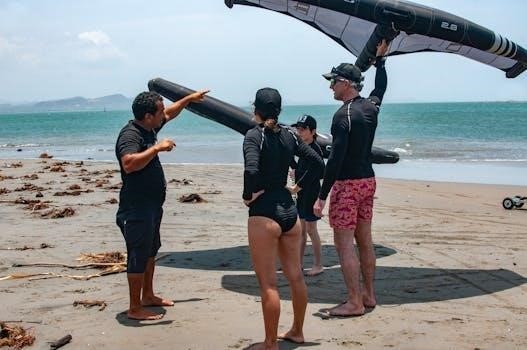Bestway Sand Filter Instructions⁚ A Comprehensive Guide
This guide provides comprehensive instructions for Bestway sand filters‚ ensuring efficient pool water cleaning. Learn about safety‚ component verification‚ suitable sand types‚ installation‚ and maintenance. Follow these steps for a clean and refreshing swimming experience. Consult the manual for damaged or missing parts.

Safety Precautions and Warnings
Prioritize safety when operating the Bestway sand filter. Always unplug the pump before maintenance. Reduce injury risks by preventing children from using the product. Read and follow all instructions in the user manual. These guidelines address common risks but cannot cover all situations. Ensure continued shock protection.
The sand filter is designed for swimming pools only. Do not bury the power cord. Position it to minimize tripping hazards. Sharp objects‚ oil‚ moving parts‚ and heat should not affect the sand filter. If the sand filter malfunctions‚ keep people out of the pool. Consult Bestway’s customer service for assistance.
Carefully read‚ understand‚ and follow all information in the user manual before installing and using the filter pump. These warnings‚ instructions‚ and safety guidelines address some common risks of water filtration systems‚ but they cannot cover all risks and dangers in all cases.
Always disconnect the product from the power outlet before relocating‚ servicing‚ or making adjustments. Ground fault circuit interrupter (GFCI) protection is required.
Initial Inspection and Parts Verification
Before assembling your Bestway sand filter‚ conduct a thorough initial inspection. Carefully examine and verify that all components are present as outlined in the parts list within the user manual. This step is crucial to ensure a smooth and efficient setup process. Familiarize yourself with each part‚ referencing the diagrams provided in the manual for accurate identification.
If you discover any damaged or missing parts upon inspection‚ do not proceed with the assembly. Immediately notify Bestway’s customer service department at the address listed in the manual. Provide them with details about the missing or damaged components for prompt assistance and replacement. Using incomplete or damaged parts can compromise the filter’s performance and safety.

Take a few minutes to become familiar with all the sand filter parts. (See Fig 1) This proactive approach will save you time and prevent potential issues during the installation process; A complete and undamaged set of components is essential for the proper functioning of your Bestway sand filter.
Sand Filter Components Overview
Understanding the key components of your Bestway sand filter is crucial for proper operation and maintenance. Familiarize yourself with each part to ensure efficient assembly‚ troubleshooting‚ and long-term performance. The main components typically include the control valve‚ which directs water flow for filtration‚ backwashing‚ and rinsing.
The pressure gauge monitors the internal pressure of the filter‚ indicating when backwashing is necessary. The top tank houses the sand media‚ which filters out dirt and debris. Strainer components prevent large particles from entering the pump. The pump itself circulates water through the filter system.
Each component plays a vital role in the overall filtration process. The control valve allows you to switch between different modes‚ optimizing water flow for various functions. The pressure gauge provides valuable information about the filter’s condition‚ helping you maintain optimal performance. Understanding these components will empower you to effectively manage and maintain your Bestway sand filter.
Suitable Sand Types and Quantities
Selecting the correct sand type and quantity is vital for optimal sand filter performance. Bestway sand filters typically require silica sand‚ specifically graded for pool filtration systems. This type of sand has a consistent particle size‚ allowing for effective removal of dirt and debris from the pool water. Avoid using play sand or other types of sand‚ as they may contain impurities or have an inconsistent particle size‚ leading to poor filtration and potential damage to the filter system.
The required sand quantity varies depending on the specific Bestway sand filter model. Refer to your sand filter’s manual for the exact amount of sand needed. Overfilling or underfilling the filter with sand can negatively impact its performance. Using the correct quantity ensures proper water flow and filtration efficiency.

Consider using Flowclear Polysphere as an alternative to sand. 28g of Polysphere replaces 1kg of sand. This alternative can be a more efficient solution to keep clean water flowing through your above ground pool. Always consult your filter’s manual for the correct type and amount of filter media to use.
Step-by-Step Installation Guide
Installing your Bestway sand filter correctly is essential for optimal performance and longevity. Before starting‚ ensure all components are present and undamaged‚ referencing the parts list in your manual. Place the filter on a solid‚ level surface‚ preferably a concrete slab‚ ensuring accessibility for operation and maintenance.
Begin by connecting the hoses to the pump and the pool‚ following the diagrams in the manual. Ensure all connections are tight and secure to prevent leaks. Next‚ add the specified amount of silica sand‚ as indicated in your manual‚ to the filter tank. Be careful not to overfill or underfill‚ as this can affect performance.
Once the sand is in place‚ attach the control valve to the filter tank‚ ensuring it is properly aligned and secured. Connect the power cord to a grounded outlet with a GFCI (Ground Fault Circuit Interrupter) for safety. Finally‚ prime the pump according to the instructions in the manual before starting the filter;
Priming the Pump
Priming the pump is a crucial step in setting up your Bestway sand filter‚ ensuring it functions correctly from the start. This process removes air from the pump and pipes‚ allowing water to flow freely. Before you begin‚ make sure the sand filter is properly connected to the pool and the control valve is in the “Backwash” position.
First‚ disconnect the hose that returns water to the pool. Next‚ slowly pour water into the pump housing until it is full. This may require multiple pours as the water settles and air escapes. Once the pump housing is full‚ reconnect the return hose to the pool securely.
Now‚ turn on the pump and observe if water starts flowing. If no water flows‚ repeat the process of filling the pump housing with water and reconnecting the hose. Once water is flowing steadily‚ allow the pump to run in the “Backwash” position for a few minutes to clear any remaining air or debris. After backwashing‚ proceed to rinse the filter before switching to the “Filter” mode for regular operation. Proper priming ensures efficient filtration and extends the life of your pump.
Control Valve Functions Explained
The control valve on your Bestway sand filter is a multi-port valve that directs water flow through the filter system‚ enabling various functions essential for maintaining clean and healthy pool water. Understanding each setting is crucial for optimal performance and longevity of your filter. The primary functions include Filter‚ Backwash‚ Rinse‚ Waste‚ Recirculate‚ and Closed.
Filter⁚ This is the standard operating mode where water flows through the sand‚ trapping dirt and debris before returning to the pool. Backwash⁚ This reverses the water flow to clean the sand bed by flushing out accumulated impurities. Regular backwashing maintains filter efficiency. Rinse⁚ After backwashing‚ use this setting to resettle the sand bed and prevent any remaining debris from entering the pool.
Waste⁚ This bypasses the filter‚ allowing water to be drained directly from the pool‚ useful for lowering water levels or removing heavy debris. Recirculate⁚ This circulates water without filtering‚ useful for distributing chemicals evenly. Closed⁚ This stops water flow completely‚ necessary for maintenance or winterizing. Each function plays a vital role in pool maintenance.
Backwashing and Rinsing Procedures
Maintaining your Bestway sand filter involves regular backwashing and rinsing to ensure optimal performance. Backwashing cleans the sand bed by reversing the water flow‚ removing trapped dirt and debris. Before starting‚ ensure the pump is off and the system is depressurized‚ indicated by a pressure gauge reading of zero.
To backwash‚ turn the control valve to the “Backwash” setting. Turn on the pump and let it run until the water in the sight glass is clear‚ typically 1-3 minutes. Turn off the pump and set the valve to “Rinse.” This resettles the sand bed after backwashing‚ preventing debris from entering the pool. Run the pump for about 30 seconds to a minute.
After rinsing‚ turn off the pump again and return the control valve to the “Filter” position for normal operation. Regularly monitor the pressure gauge; increased pressure indicates the need for backwashing. Consistent backwashing and rinsing extend the life of your sand and maintain clean pool water. Always follow the manufacturer’s instructions for your specific model.
Troubleshooting Common Issues
Encountering issues with your Bestway sand filter? Here’s a guide to troubleshoot common problems. If you notice cloudy water‚ ensure the filter is running long enough each day and that the sand is clean. Backwash the filter to remove accumulated debris; if cloudiness persists‚ the sand might need replacement.
Low water flow can result from a clogged pump strainer or filter. Clean the strainer basket and backwash the filter. Check for any kinks or blockages in the hoses. If the pressure gauge reads high‚ it indicates a dirty filter requiring backwashing. A consistently high reading after backwashing suggests the sand bed needs replacing.
If the pump isn’t priming‚ ensure the pump is below the water level and all connections are tight to prevent air leaks; Check for debris obstructing the impeller. For unusual noises‚ inspect the pump for loose components or obstructions. Always disconnect the power before attempting any repairs and consult the manual for specific guidance. If problems persist‚ seek professional assistance.
Pressure Gauge Readings and Interpretation
Understanding the pressure gauge on your Bestway sand filter is crucial for optimal performance. A normal operating pressure typically falls within a specific range‚ as indicated in your filter’s manual. This range reflects clean sand efficiently filtering water. Monitoring the pressure helps determine when maintenance is needed.
A rising pressure indicates that the sand is becoming clogged with debris. This increased resistance restricts water flow‚ making the filter work harder. When the pressure reaches 84Bar‚ it’s time to perform a backwash. Backwashing reverses the water flow‚ flushing out accumulated dirt and restoring the sand’s filtering capacity.
Conversely‚ a consistently low pressure might suggest a problem‚ such as a leak or a channel forming in the sand bed. Inspect all connections for leaks and ensure the sand is evenly distributed. If low pressure persists after addressing these issues‚ consult your manual or a professional for further guidance. Regular monitoring and prompt response to pressure changes ensure efficient filtration and prolong the life of your sand filter.
Sand Replacement Instructions
Over time‚ the sand in your Bestway sand filter loses its effectiveness and requires replacement. Before starting‚ ensure the pump is unplugged and the pressure is at zero. Consult your manual for the specific sand type and quantity required for your filter model. Typically‚ silica sand is used‚ but alternatives like Flowclear Polysphere can also be suitable‚ using 28g of Flowclear Polysphere to replace 1 kg of sand.
To begin‚ carefully disassemble the filter according to your manual’s instructions. Remove the old sand‚ taking care not to damage any internal components. Thoroughly clean the filter tank to remove any residual debris. Inspect the internal parts for wear or damage and replace them if necessary.
Next‚ refill the tank with the new sand‚ ensuring it’s evenly distributed. Follow the manufacturer’s guidelines for the correct sand level. Reassemble the filter‚ ensuring all connections are secure. After refilling and reassembling‚ perform backwash and rinse procedures as outlined in your manual to settle the sand bed and remove any fine particles. Regular sand replacement ensures optimal filtration and clean pool water.

Winterizing the Sand Filter
As colder months approach‚ proper winterization of your Bestway sand filter is crucial to prevent damage from freezing temperatures. Begin by disconnecting the filter from the power source to ensure safety. Thoroughly drain all water from the filter tank‚ pump housing‚ and hoses. This prevents water from freezing and potentially cracking the components.
Remove the drain plug at the bottom of the filter tank to facilitate complete drainage. Open the control valve and set it to the “Winterize” position‚ if available‚ or follow the specific instructions in your manual. Disconnect all hoses and fittings‚ and store them in a dry‚ protected area to prevent deterioration.
Inspect the sand for any debris or buildup. If necessary‚ remove the sand and clean the filter tank thoroughly. Store the sand separately in a dry container to prevent moisture absorption. Cover the filter with a waterproof tarp or store it indoors to protect it from the elements. Following these steps ensures your sand filter remains in good condition‚ ready for use when warmer weather returns.
Maintenance Tips for Longevity
To ensure the longevity and optimal performance of your Bestway sand filter‚ regular maintenance is essential. Start by frequently checking the pressure gauge; unusually high readings indicate the need for backwashing. Perform backwashing and rinsing procedures as recommended in the manual to remove accumulated debris and maintain proper water flow.
Inspect the sand regularly for clumping or contamination. Replace the sand every 3-5 years‚ or sooner if necessary‚ to maintain effective filtration. Keep the filter housing clean and free from debris. Check all hoses and connections for leaks or damage‚ replacing them as needed to prevent water loss and maintain system pressure.
Protect the filter from direct sunlight and harsh weather conditions by providing shade or covering it when not in use. During the off-season‚ properly winterize the filter to prevent freezing and damage. Ensure the pump is unplugged before performing any maintenance. By following these simple tips‚ you can extend the life of your sand filter and enjoy clean‚ clear pool water for years to come. Always refer to your specific model’s manual for detailed instructions.
